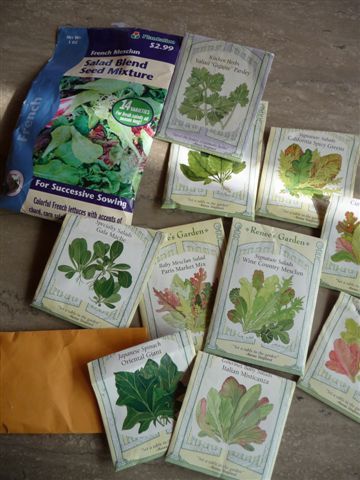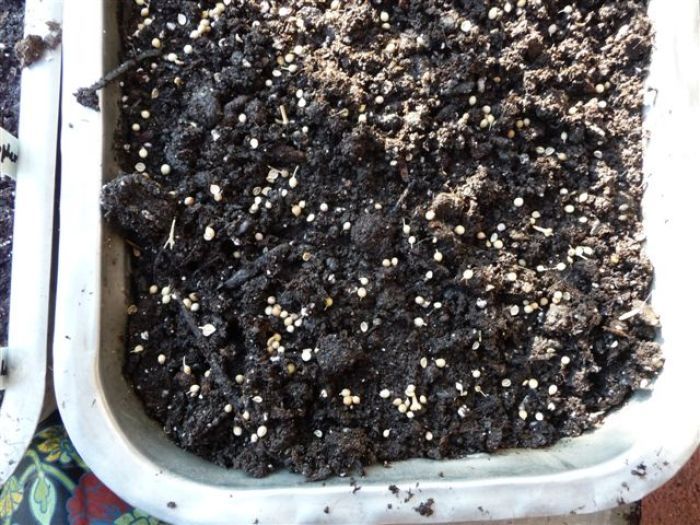
Although it is only February and I have another month or two of winter here in my zone 7 Maryland garden, today I am sowing seeds in flats to grow salad greens and a few annual herbs in my greenhouse. There is still snow on the ground outside and it is only in the 30s, however the salad greens will do okay in the cool temperatures of the greenhouse. Renee Shepherd has been selling fine seeds for many years now–every year I order her packets of salad greens–she combines and packages wonderful salad mixes from Italian misticanza and French mesclun to spicy stir fry mixes. Check out Renee’s Garden Web site for her seed mixes and also her special discounted offer to schools and non-profit organizations.
I have been waiting for the moon to be right—and today it is in a fruitful sign in the first quarter so it is perfect for planting aboveground annual crops like leafy greens. I use the Llewellyn Moon Sign Book as well as the Old Farmers’ Almanac to keep track of the moon phases, besides observing it in the sky. I truly believe that with the waxing and waning of the moon affecting the tides of our oceans and the moisture in the earth (not to mention we human beings), that planting by the moon does have an affect on the plants we grow.
Indoors, start the seed in flats or small plastic pots that are brand new, or if used, they need to be scrubbed clean and dipped in a 10% bleach solution. Prepare these by filling them with a seed-starting mix like Promix ™ which is a soilless potting medium, or make your own by combining equal parts spaghnum peat with perlite or vermiculite. Dampen this medium thoroughly before sowing seed. It should not be soaking wet. Place two or three seeds in each pot or make rows in a flat. Some gardeners think that seeds planted in rows, rather than scattered, have fewer problems after germination because of improved air circulation. However sometimes, I scatter or broadcast seeds, especially when I am harvesting or thinning seedlings and not transplanting them. Cover the seeds lightly with a thin layer of dampened potting mix. Cover germinating flats with a plastic dome or plastic wrap to preserve moisture. Be sure to put tags in the flats so that you know what you are growing, or keep a notebook with a sketch. I make notes in my gardening journal of when I sow seed, days they germinate, when I transplant, etc.
Most seeds germinate in a warm dark, place, so a heat mat is very useful but not absolutely necessary for germinating seed, especially for cooler weather crops. Seed should sprout in a week to ten days; some sprout in a few days while others like parsley may take longer. For instance, some lettuces might germinate in two days, while some chile peppers take more than two weeks. So be patient. Once your seeds have germinated, move them to the light. I use grow lights early in the season; a twin-tube fluorescent grow light will speed sturdy development, but a sunny window or cold frame will suffice.
Water with a fine mist or a watering can with a sprinkling head. The soil should be kept evenly damp but not wet, and never allowed to dry out. You can tell when the flats need water by the color of the medium and the weight of the container. Take care not to over water or the plants may rot at the soil level.
When the seedlings are one to two inches tall, fertilize them lightly; I use kelp/fish emulsion. Once they reach three or four inches in height, I start thinning and eat the baby greens and herbs in my salad. I will keep you posted as to the progression of growth of my just-planted flats and let you see my first harvest. Meanwhile, just the sowing of seed has cheered me and warmed my being on this cold winter day.
Good days for planting annuals this week are: February 9 (6:22 am) to February 11 (2:18 am) moon in Taurus, 1st quarter moon and February 11 (2:18am) to (5:20 pm), 2nd quarter.





























Comments
Log in or create an account to post a comment.
Sign up Log in